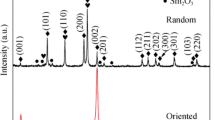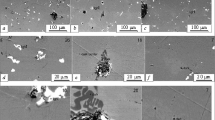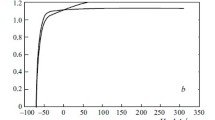Conclusions
A study was made of the effect of time of sintering at 1120–1170°C on the magnetic characteristics of SmCo5 magnets. It was established that the specific magnetization intensity and coercive force of these magnets change appreciably at the beginning of sintering (τs < 5 min), but subsequently vary but little with sintering time. The presence of a low-meltingpoint addition was found to have no effect on the densification rate of SmCo5 powder compacts. The sintering of SmCo5 magnets of optimum chemical composition occurs in the solid state irrespective of the method by which the SmCo5 powder has been enriched in samarium. It is proposed that a Sm2Co7 alloy powder be employed for this purpose. Structural equilibrium in particles, which is chiefly responsible for the magnetic characteristics of sintered SmCO5 specimens, becomes established in a short period of time thanks to a high value of coefficient of diffusion.
Similar content being viewed by others
Literature cited
M. G. Benz and D. L. Martin, “Cobalt—samarium permanent magnets prepared by liquid-phase sintering,” Appl. Phys. Letters,17, No. 4, 176–177 (1970).
E. E. Ray, “A review of the binary rare-earth—cobalt systems,” Cobalt, No. 1, 13–20 (1974).
A. S. Kononenko, V. V. Sergeev, and Yu. M. Rabinovich, “Correlation between the properties of rare-earth-metal—cobalt magnets densified by liquid-phase sintering and sintering, annealing, and powder milling conditions,” in: Electrical Materials [in Russian], Vol. 2, Informelektro (1974), pp. 13–15.
M. G. Benz and D. L. Martin, “Mechanism of sintering in cobalt—rare-earth permanent-magnet alloys,” J. Appl. Phys.,43, No. 7, 3165–3170 (1972).
P. J. Jorgensen and R. W. Bartlett, “Liquid-phase sintering of SmCo5,” J. Appl. Phys.,44., No. 6, 2876–2879 (1973).
G. H. Gessinger and E. de Lamotte, “Der Sintermechanismus von Samarium—Kobalt-Legierungen,” Z. Metallk.,64, No. 11, 771–775 (1973).
P. J. Jorgensen and R. W. Bartlett, “Solid-phase sintering of SmCo5,” J. Less-Common Metals,37, No. 2, 205–212 (1974).
A. N. Savich, “An investigation of the properties of magnets of the intermetallic compound SmCo5 and of methods of their preparation,” Author's Abstract of Candidate's Dissertation, Moscow (1974).
G. M. Fedichkin and I. N. Borodulin, “Kinetics of evaporation of the compound SmCo5 from an open surface in a vacuum,” in: Physics of Magnetic Materials [in Russian], Intercollegiate Collection of Scientific Papers, Vol. 2, Izd. KGU, Kalinin (1974), pp. 34–38.
Ya. E. Geguzin, Physics of Sintering [in Russian], Nauka, Moscow (1967).
G. M. Fedichkin, “An investigation of the processes of evaporation and oxidation of samarium—cobalt compounds from the standpoint of manufacture and heat treatment of permanent magnets based on them,” Author's Abstract of Candidate's Dissertation, Moscow (1977).
Author information
Authors and Affiliations
Additional information
Translated from Poroshkovaya Metallurgiya, No. 3(183), pp. 70–75, March, 1978.
Rights and permissions
About this article
Cite this article
Kononenko, A.S., Sergeev, V.V. Effect of time of sintering on some properties of SmCo5 magnets. Powder Metall Met Ceram 17, 222–226 (1978). https://doi.org/10.1007/BF00791433
Received:
Issue Date:
DOI: https://doi.org/10.1007/BF00791433




